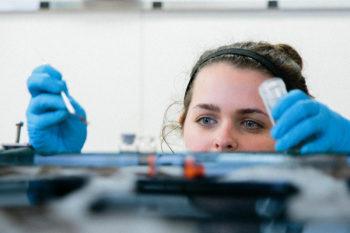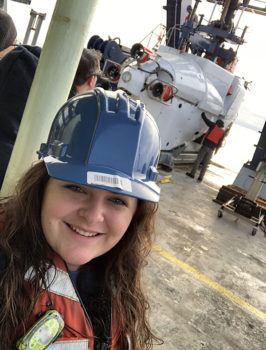Undergraduate Research At Sea
After graduating from MacArthur High School in San Antonio, Mia Self ’21 moved to Texas A&M University to pursue a degree in environmental studies within the College of Geosciences.
Two and half years later, she was walking down a dock in San Francisco, about to board the R/V Atlantis to spend five-weeks of her spring 2019 semester conducting research in the East Pacific Ocean.
“It felt like I was about to take huge drop on a rollercoaster. It was a mix of anticipation, excitement, nervousness — it didn’t seem real. We talked about this cruise all semester and I couldn’t believe it was finally happening,” she said.
How did a college sophomore get to sail on such a trip?
In August 2018, she started working in Texas A&M Oceanography Professor Dr. Jason Sylvan’s lab, doing DNA extractions. In December he presented her with the opportunity to participate on the 5-week research cruise to investigate hydrothermal vents, and she leaped at the opportunity.
She had already made her schedule for the upcoming semester. “I didn’t think it was possible, because it was 5 weeks, and I didn’t think it was possible to miss that much class,” Self said.
Balancing coursework and research opportunities
“Dr. Brendan Roark and Allison Harms were definitely a huge, huge help with trying to figure out how to make all of this happen. Dr. Roark was the one who initially stated, ‘It’s possible for you to go,’” she explained.
With the help of Roark, head of Environmental Programs in the College of Geosciences, and Sylvan’s assistance, she was able to configure her schedule to accommodate the cruise, which sailed March 25 – April 24.
“I was only in one lecture-based class this semester; the rest of my classes were research-based,” Self said. “In one of my research classes, I was continuing the DNA extraction research for a different project in the lab, and the other was getting prepared for the actual cruise.”
“I would do anywhere from 15 to 20 hours a week in the lab, and then my final class was reading a lot of research papers, meeting with Dr. Sylvan, and I got a crash course in microbial ecology.”
Everything during her semester was focused around the cruise and gaining the experience, but it wouldn’t have been possible without the help and support of her professors and advisors.
Researching hydrothermal vents in the deep ocean
The research project led by Sylvan, Hot2Cold Vents, was created to figure out the biological component of hydrothermal vents, attempting to answer the question: “Whenever an alive hydrothermal vent becomes a dead hydrothermal vent, when does the biology change?”
“I specifically went on the cruise to study enzymes and the biological difference between hot (alive) and cold (dead) hydrothermal vents,” Mia said.
After collecting samples on the East Pacific Rise using Alvin, a human occupied vehicle (HOV) submarine, they would put “half of the samples in a 65-degree incubator and half inside a 4-degree refrigerator.” Self would then “look at the different enzyme activity based upon dead hydrothermal vents and alive hydrothermal vent rocks at the two different temperatures to see what the different enzyme and rate activities were.”
An extremely rare opportunity for an undergraduate student, Self got to dive in HOV Alvin, deep into the Pacific Ocean. Alvin holds three people at a time, usually two scientists and one pilot, and each dive on this expedition lasted for about 8 hours.
“We used Alvin as a means of collecting samples for all of our different projects that we needed, and we would go there for 8 hours at a time to collect samples from different hydrothermal vents. We were 2,521 meters down, and there were things I never would have even imagined were down there.”
“After a week, we went back and resampled those rocks, and they’re going back next year to see how everything has changed after a day, a week, and a year to see when the cutoff was for when everything changed between an alive and dead hydrothermal vents,” she explained.
Now a junior, she has started to look towards the future and what she hopes to accomplish following the completion of her bachelor’s degree.
“I definitely know that graduate school is in my future. I know that I want to do something with the environment, but I don’t really have a huge direction for a career yet; but I know with a school as amazing as A&M that I will have many opportunities to figure it out in my next two years while I’m here.”
This article by Amanda Hoth originally appeared in Geosceinces News.





